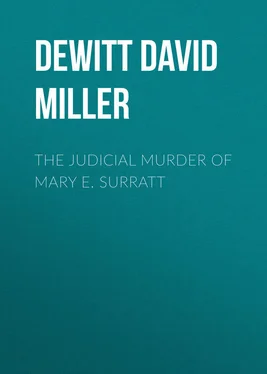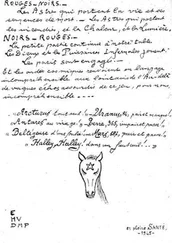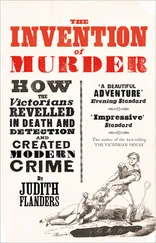David DeWitt - The Judicial Murder of Mary E. Surratt
Здесь есть возможность читать онлайн «David DeWitt - The Judicial Murder of Mary E. Surratt» — ознакомительный отрывок электронной книги совершенно бесплатно, а после прочтения отрывка купить полную версию. В некоторых случаях можно слушать аудио, скачать через торрент в формате fb2 и присутствует краткое содержание. Жанр: foreign_antique, foreign_prose, на английском языке. Описание произведения, (предисловие) а так же отзывы посетителей доступны на портале библиотеки ЛибКат.
- Название:The Judicial Murder of Mary E. Surratt
- Автор:
- Жанр:
- Год:неизвестен
- ISBN:нет данных
- Рейтинг книги:5 / 5. Голосов: 1
-
Избранное:Добавить в избранное
- Отзывы:
-
Ваша оценка:
- 100
- 1
- 2
- 3
- 4
- 5
The Judicial Murder of Mary E. Surratt: краткое содержание, описание и аннотация
Предлагаем к чтению аннотацию, описание, краткое содержание или предисловие (зависит от того, что написал сам автор книги «The Judicial Murder of Mary E. Surratt»). Если вы не нашли необходимую информацию о книге — напишите в комментариях, мы постараемся отыскать её.
The Judicial Murder of Mary E. Surratt — читать онлайн ознакомительный отрывок
Ниже представлен текст книги, разбитый по страницам. Система сохранения места последней прочитанной страницы, позволяет с удобством читать онлайн бесплатно книгу «The Judicial Murder of Mary E. Surratt», без необходимости каждый раз заново искать на чём Вы остановились. Поставьте закладку, и сможете в любой момент перейти на страницу, на которой закончили чтение.
Интервал:
Закладка:
On this elastic comprehensive Charge, in which treason and murder are vaguely commingled, every one of the men, and Mary E. Surratt, were arraigned, plead not guilty, and were put upon trial. There is no doubt, by the way, that the Secretary of War would have been included as one of the contemplated victims, had not Edwin M. Stanton borne so prominent a part in the prosecution; and it was for this reason, and not because of any change in the evidence, that General Grant stood alone, as the mark of O’Laughlin.
To this single Charge there was, also, but a single Specification. This document alleged that the design of all these traitorous conspirators was, to deprive the Army and Navy of their Commander-in-Chief and the armies of their Commander; to prevent a lawful election of President and Vice-President; and by such means to aid and comfort the Rebellion and overthrow the Constitution and laws.
It then alleged the killing of Abraham Lincoln by Booth in the prosecution of the conspiracy, and charged the murder to be the act of the prisoners, as well as of Booth and John H. Surratt. It then alleged that Spangler, in furtherance of the conspiracy, aided Booth in obtaining entrance to the box of the theatre, in barring the door of the theatre box, and in effecting his escape. Then, that Herold, in furtherance of the conspiracy, aided and abetted Booth in the murder, and in effecting his escape. Then, that Payne, in like furtherance, made the murderous assault on Seward and also on his two sons and two attendants. Then, that Atzerodt, in like furtherance, at the same hour of the night, lay in wait for Andrew Johnson with intent to kill him. Then, that Michael O’Laughlin, in like furtherance, on the nights of the 13th and 14th of April, lay in wait for General Grant with like intent. Then, that Samuel Arnold, in prosecution of the conspiracy, “did, on or before the 6th day of March, 1865, and on divers other days and times between that day and the 15th day of April, 1865, combine, conspire with and counsel, abet, comfort and support” Booth, Payne, Atzerodt, O’Laughlin and their confederates. Then, “that, in prosecution of the conspiracy, Mary E. Surratt, on or before the 6th of March, 1865, and on divers other days and times between that day and the 20th of April, 1865, received, entertained, harbored and concealed, aided and assisted” Booth, Herold, Payne, John H. Surratt, O’Laughlin, Atzerodt, Arnold and their confederates, “with the knowledge of the murderous and traitorous conspiracy aforesaid, and with intent to aid, abet and assist them in the execution thereof, and in escaping from justice.” And, lastly, that in prosecution of the conspiracy Samuel A. Mudd did from on or before the 6th day of March, to the 20th of April “advise, encourage, receive, entertain, harbor and conceal, aid and assist” Booth, Herold, Payne, John H. Surratt, O’Laughlin, Atzerodt, Mary E. Surratt, Arnold and their confederates, in its execution and their escape.
After the prisoners, who as yet had no counsel, had pleaded not guilty to the Charge and Specification, the Court adopted rules of proceeding – one of which was that the sessions of the Court should be secret, and no one but the sworn officers and the counsel for the prisoners, also sworn to secrecy, should be admitted, except by permit of the President of the Commission; and that only such portions of the testimony as the Judge-Advocate should designate should be made public.
On the next day (Thursday, May 11th), Mr. Thomas Ewing, Jr. and Mr. Frederick Stone appeared as counsel for Dr. Mudd, and Mr. Frederick A. Aiken and Mr. John W. Clampitt for Mrs. Surratt; and on the succeeding day (12th), Mr. Frederick Stone appeared for Herold “at the earnest request of his widowed mother and estimable sisters;” General Ewing for Arnold (and on Monday, the 15th, for Spangler); Mr. Walter S. Cox for O’Laughlin, and Mr. William E. Doster for Payne and Atzerodt.
By the rules of the Commission no counsel could appear for the prisoners unless he took the “iron-clad oath” or filed evidence of having taken it. So supersensitive was the loyalty of the Court that it could not brook the presence of a “sympathizer with the South,” even in such a confidential relation as counsel for accused conspirators in aid of the Rebellion.
The demeanor of the Court towards the counsel for the defense, reflecting as in a mirror the humor of the Judge-Advocates, was highly characteristic. Sometimes they were treated with haughty indifference, sometimes with ironical condescension, often with contumely, generally with contempt. Their objections were invariably overruled, unless acceded to by the Judge-Advocate. The Commission could not conceal its secret opinion that they were engaged in a disreputable and disloyal employment.
This statement must be somewhat qualified, however, so far as it relates to General Ewing. He was, or had been recently, of equal rank in the army of the Union with the members of the Court. He was a brother-in-law of General Sherman, and he had acquired a high reputation for gallantry and skill, as well as loyalty, during the war. That such a distinguished fellow-soldier should appear to defend the fiendish murderers of their beloved Commander-in-Chief – outlaws they were detailed as a Court to hang – evidently perplexed and disconcerted these military Judges and tended in some degree to curb the over-bearing insolence of the Special Judge-Advocate. Thus, this able lawyer and gallant officer and noble man was enabled to be “the leading spirit of the defense;” and, as we shall see, he wrought the miracle of plucking from the deadly clutches of the Judge-Advocates the lives of every one of the men he defended. But this instance was a most notable exception. As a rule, even the silent presence of the counsel for the accused jarred upon the feelings of the Court, and their vocal interference provoked, at intervals, its outspoken animadversion. A trifling incident will serve to illustrate.
The witnesses, while giving their testimony, were required to face the Court, so that they necessarily turned their backs on the counsel for the prisoners who were placed some distance behind the witness-stand. These counsel were also forced to cross-examine the witnesses for the prosecution, and interrogate their own, without seeing their faces; and as often as a witness in instinctive obedience to the dictates of good manners would turn round to answer a question, the President of the Court would check him by a “sharp reprimand” and the stern admonition: “Face the Court!” The confusion of a witness, especially for the defense, when thundered at in this way by General Hunter, and the reiterated humiliation of counsel implied in the order, seem to have only called forth the wonder that witnesses “would persist in turning towards the prisoners’ counsel!”
Clearly these lawyers were an unmeaning, an impeding, an offensive, though unavoidable, superfluity.
CHAPTER II.
Animus of the Judges
On Saturday, the 13th of May, an incident occurred which throws much light upon the judicial temper of the Court at the very beginning of the trial. On that day Reverdy Johnson appeared as counsel for Mrs. Surratt. Admitted to the bar in 1815, Senator of the United States as far back as 1845, Attorney-General of the United States as long ago as 1849, and holding the position of Senator of the United States again at that very moment; having taken the constitutional oath in all the Courts including the Supreme Court of the United States at whose bar he was one of the most eminent advocates; three years after this time to be Minister Plenipotentiary to England; as he stood there, venerable both in years and in honors, appearing at great personal and professional sacrifice, gratuitously, for a woman in peril of her life, one would have thought him secure at least from insult. Yet no sooner did he announce his intention, if the Court would permit him at any time to attend to his imperative duties elsewhere, to act as counsel, than the President of the Commission read aloud a note he had received from one of his colleagues objecting “to the admission of Reverdy Johnson as a counsel before this Court on the ground that he does not recognize the moral obligation of an oath that is designed as a test of loyalty;” and, in support of the objection, referring to Mr. Johnson’s letter to the people of Maryland pending the adoption of the new constitution of 1864.
Читать дальшеИнтервал:
Закладка:
Похожие книги на «The Judicial Murder of Mary E. Surratt»
Представляем Вашему вниманию похожие книги на «The Judicial Murder of Mary E. Surratt» списком для выбора. Мы отобрали схожую по названию и смыслу литературу в надежде предоставить читателям больше вариантов отыскать новые, интересные, ещё непрочитанные произведения.
Обсуждение, отзывы о книге «The Judicial Murder of Mary E. Surratt» и просто собственные мнения читателей. Оставьте ваши комментарии, напишите, что Вы думаете о произведении, его смысле или главных героях. Укажите что конкретно понравилось, а что нет, и почему Вы так считаете.












